A lifespan analysis of intraneocortical connections and gene expression in the mouse I
- PMID: 21060110
- PMCID: PMC3140180
- DOI: 10.1093/cercor/bhq212
A lifespan analysis of intraneocortical connections and gene expression in the mouse I
Abstract
A hallmark of mammalian evolution is the structural and functional complexity of the cerebral cortex. Within the cerebral cortex, the neocortex, or isocortex, is a 6-layered complexly organized structure that is comprised of multiple interconnected sensory and motor areas. These areas and their precise patterns of connections arise during development, through a process termed arealization. Intrinsic, activity-independent and extrinsic, activity-dependent mechanisms are involved in the development of neocortical areas and their connections. The intrinsic molecular mechanisms involved in the establishment of this sophisticated network are not fully understood. In this report (I) and the companion report (II), we present the first lifespan analysis of ipsilateral intraneocortical connections (INCs) among multiple sensory and motor regions, from the embryonic period to adulthood in the mouse. Additionally, we characterize the neocortical expression patterns of several developmentally regulated genes that are of central importance to studies investigating the molecular control of arealization from embryonic day 13.5 to postnatal day (P) 3 (I) and P6 to 50 (II). In this analysis, we utilize novel methods to correlate the boundaries of gene expression with INCs and developing areal boundaries, in order to better understand the nature of gene-areal relationships during development.
Figures

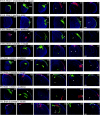
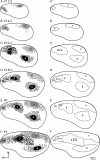

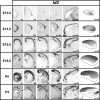
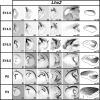
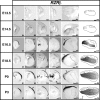
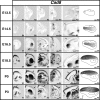
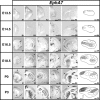
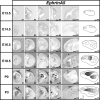

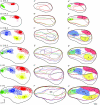
Similar articles
-
A lifespan analysis of intraneocortical connections and gene expression in the mouse II.Cereb Cortex. 2011 Jun;21(6):1331-50. doi: 10.1093/cercor/bhq213. Epub 2010 Nov 8. Cereb Cortex. 2011. PMID: 21060113 Free PMC article.
-
Bilateral enucleation alters gene expression and intraneocortical connections in the mouse.Neural Dev. 2012 Jan 30;7:5. doi: 10.1186/1749-8104-7-5. Neural Dev. 2012. PMID: 22289655 Free PMC article.
-
Graded and areal expression patterns of regulatory genes and cadherins in embryonic neocortex independent of thalamocortical input.J Neurosci. 1999 Dec 15;19(24):10877-85. doi: 10.1523/JNEUROSCI.19-24-10877.1999. J Neurosci. 1999. PMID: 10594069 Free PMC article.
-
Gene networks controlling early cerebral cortex arealization.Eur J Neurosci. 2006 Feb;23(4):847-56. doi: 10.1111/j.1460-9568.2006.04634.x. Eur J Neurosci. 2006. PMID: 16519650 Review.
-
Neocortical areas, layers, connections, and gene expression.Neurosci Res. 2006 May;55(1):11-27. doi: 10.1016/j.neures.2006.02.006. Epub 2006 Mar 20. Neurosci Res. 2006. PMID: 16546282 Review.
Cited by
-
GDF10 is a signal for axonal sprouting and functional recovery after stroke.Nat Neurosci. 2015 Dec;18(12):1737-45. doi: 10.1038/nn.4146. Epub 2015 Oct 26. Nat Neurosci. 2015. PMID: 26502261 Free PMC article.
-
Prenatal ethanol exposure disrupts intraneocortical circuitry, cortical gene expression, and behavior in a mouse model of FASD.J Neurosci. 2013 Nov 27;33(48):18893-905. doi: 10.1523/JNEUROSCI.3721-13.2013. J Neurosci. 2013. PMID: 24285895 Free PMC article.
-
Rapid Changes in Cortical and Subcortical Brain Regions after Early Bilateral Enucleation in the Mouse.PLoS One. 2015 Oct 9;10(10):e0140391. doi: 10.1371/journal.pone.0140391. eCollection 2015. PLoS One. 2015. PMID: 26452243 Free PMC article.
-
The effects of lifelong blindness on murine neuroanatomy and gene expression.Front Aging Neurosci. 2015 Jul 24;7:144. doi: 10.3389/fnagi.2015.00144. eCollection 2015. Front Aging Neurosci. 2015. PMID: 26257648 Free PMC article.
-
Thalamocortical circuits for the formation of hierarchical pathways in the mammalian visual cortex.Front Neural Circuits. 2023 Apr 17;17:1155195. doi: 10.3389/fncir.2023.1155195. eCollection 2023. Front Neural Circuits. 2023. PMID: 37139079 Free PMC article. Review.
References
-
- Abu-Khalil A, Fu L, Grove EA, Zecevic N, Geschwind DH. Wnt genes define distinct boundaries in the developing human brain: implications for human forebrain patterning. J Comp Neurol. 2004;474:276–288. - PubMed
-
- Armentano M, Chou SJ, Tomassy GS, Leingärtner A, O'Leary DD, Studer M. COUP-TFI regulates the balance of cortical patterning between frontal/motor and sensory areas. Nat Neurosci. 2007;10:1277–1286. - PubMed
-
- Auladell C, Pérez-Sust P, Supèr H, Soriano E. The early development of thalamocortical and corticothalamic projections in the mouse. Anat Embryol. 2000;201:169–179. - PubMed
-
- Bai W, Ishida M, Okabe M, Arimatsu Y. Role of the protomap and target-derived signals in the development of intrahemispheric connections. Cereb Cortex. 2006;16:124–135. - PubMed
-
- Bishop K, Goudreau G, O'Leary DD. Regulation of area identity in the mammalian neocortex by Emx2 and Pax6. Science. 2000;288:344–349. - PubMed
Publication types
MeSH terms
Substances
Grants and funding
LinkOut - more resources
Full Text Sources
Molecular Biology Databases
Research Materials

